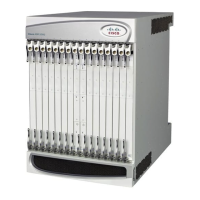Mobility Management Entity Overview
▀ Features and Functionality - Base Software
▄ Cisco ASR 5000 Series Product Overview
Important: For more information on command line interface based management, refer Command Line Interface
Reference.
Bulk Statistics Support
The system's support for bulk statistics allows operators to choose to view not only statistics that are of importance to
them, but also to configure the format in which it is presented. This simplifies the post-processing of statistical data
since it can be formatted to be parsed by external, back-end processors.
When used in conjunction with the Web Element Manager, the data can be parsed, archived, and graphed.
The system can be configured to collect bulk statistics (performance data) and send them to a collection server (called a
receiver). Bulk statistics are statistics that are collected in a group. The individual statistics are grouped by schema.
Following is a partial list of supported schemas:
System: Provides system-level statistics
Card: Provides card-level statistics
Port: Provides port-level statistics
MME: Provides MME service statistics
GTPC: Provides GPRS Tunneling Protocol - Control message statistics
GTPU: Provides GPRS Tunneling Protocol - User message statistics
The system supports the configuration of up to 4 sets (primary/secondary) of receivers. Each set can be configured with
to collect specific sets of statistics from the various schemas. Statistics can be pulled manually from the chassis or sent
at configured intervals. The bulk statistics are stored on the receiver(s) in files.
The format of the bulk statistic data files can be configured by the user. Users can specify the format of the file name,
file headers, and/or footers to include information such as the date, chassis host name, chassis uptime, the IP address of
the system generating the statistics (available for only for headers and footers), and/or the time that the file was
generated.
When the Web Element Manager is used as the receiver, it is capable of further processing the statistics data through
XML parsing, archiving, and graphing.
The Bulk Statistics Server component of the Web Element Manager parses collected statistics and stores the information
in the PostgreSQL database. If XML file generation and transfer is required, this element generates the XML output and
can send it to a Northbound NMS or an alternate bulk statistics server for further processing.
Additionally, if archiving of the collected statistics is desired, the Bulk Statistics server writes the files to an alternative
directory on the server. A specific directory can be configured by the administrative user or the default directory can be
used. Regardless, the directory can be on a local file system or on an NFS-mounted file system on the Web Element
Manager server.
Threshold Crossing Alerts (TCA) Support
Thresholding on the system is used to monitor the system for conditions that could potentially cause errors or outage.
Typically, these conditions are temporary (i.e high CPU utilization, or packet collisions on a network) and are quickly

